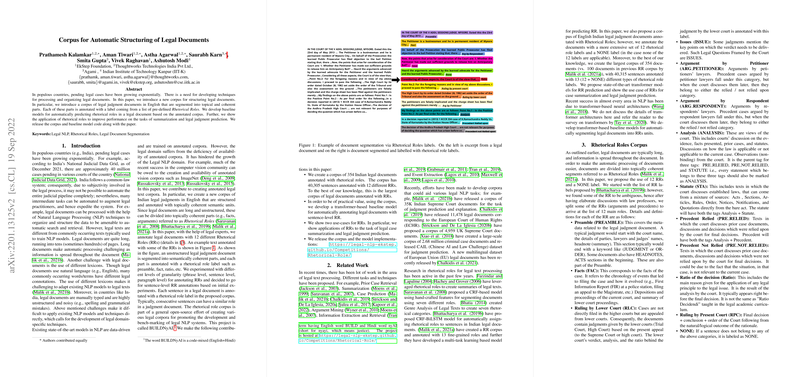An Analysis of Techniques for Structuring Legal Documents Using Rhetorical Roles
The paper "Corpus for Automatic Structuring of Legal Documents" addresses a critical problem in the domain of legal NLP: the structuring and understanding of lengthy and complex legal documents. This paper introduces a new corpus of annotated legal texts and develops baseline models to advance the automatic segmentation of such documents using rhetorical roles (RRs). These foundational efforts aim to enhance legal document processing, potentially offering improved efficiencies in legal systems challenged by exponential growth in case load, as seen in jurisdictions like India.
Legal texts present unique challenges that differ significantly from other corpora typically used to train NLP models. Their length, specialized lexicons, and context-specific terminology hinder existing NLP systems' efficacy. Recognizing these facts, the authors focus on crafting domain-specific techniques, starting with the introduction of a corpus comprised of segmented legal judgments annotated with twelve predefined rhetorical roles. These roles, determined with insights from legal experts, segment judicial texts into semantic units such as facts, arguments, and judgments. Such annotation aims to facilitate tasks like search, summarization, and information retrieval by structuring unstructured legal texts.
The paper's methodology involves a comprehensive annotation process, employing crowdsourcing techniques to enlist and train law students for segmenting legal documents. The resulting corpus includes over 40,000 annotated sentences from 354 Indian legal documents, one of the most extensive datasets available for this specific NLP challenge. The annotations were evaluated using agreement metrics like Fleiss Kappa, which, while indicating moderate agreement, highlight areas for future refinement.
Baseline models, including BERT-based transformer architectures, were developed to predict rhetorical roles. Among these, the SciBERT-HSLN model showed superior performance, yielding a weighted F1 score of 78% on the test dataset. However, the paper reports challenges in differentiating between specific roles due to overlapping contexts within legal documents—an issue observed among both human annotators and baseline models.
Moreover, the applications of rhetorical role predictions are explored through tasks such as extractive and abstractive summarization and court judgment prediction. Enhanced summarization models incorporating rhetorical roles demonstrated improved ROUGE scores, suggesting effective extraction of relevant information for concise summaries. Similarly, the implementation of rhetorical roles in judgment prediction models resulted in better performance metrics, thus validating their potential utility in processing legal documents.
The implications of this research are noteworthy, paving the way for more nuanced and intelligent legal document analysis tools. The release of the corpus and baseline models invites further exploration, with avenues for development including enhancing role prediction accuracy through advanced learning techniques and expanding applications to broader legal tasks. As the legal NLP field progresses, this work establishes a substantial benchmark for future research and applications tailored to legal documents.
